-
May 1 1966
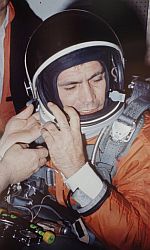
A pilot suffers an explosive decompression during a balloon flight
On this day in 1966, Nick Piantanida a trucker and parachutist from New Jersey, suffered the most violent decompression ever experienced by a human being when his suit depressurized while attempting to perform a high-altitude jump from a balloon in the stratosphere. This was the third attempt by the pilot after a balloon burst and mechanical problems in previous flights.
Once airborne, everything went normally until the balloon approached 17,3 km. At that moment, the ground crew heard a "whoosh" over the communication line, followed by an "Emergen..." call from Nick. They cut the balloon loose, and the gondola parachuted to the ground. Rescue crews found him unconscious and unresponsive. Piantanida was taken to the local hospital, then was put into a hyperbaric chamber at a hospital in Minneapolis, and finally transferred to the National Institute of Health hospital in Bethesda, Maryland. He never regained consciousness and finally died on August 25, 1966.
The evidence available seems to indicate that Nick opened his helmet visor at that extreme altitude, allowing the air in the suit to rush out forcing the air from his lungs, and rapidly incapacitating him. The best source on the matter is the book "Magnificient Failure" by Craig Ryan. -
May 4 1961
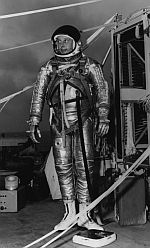
Stratolab V mission ends in tragedy
On this day in 1961 Commander Malcolm D. Ross and Liutenant Commander Victor A. Prather, crewed a two-place open gondola under Stratolab project. They departed from the deck of the U.S.S. Antietam (CVS 36) steaming off the mouth of the Mississippi River.
That was the largest balloon ever employed to date on a manned flight, and attained a world record balloon altitude of 113,739.9 feet, 2 hours, 36 minutes after liftoff at a position about 136 miles south of Mobile, Alabama. After returning to the sea surface, both pilots were meant to be rescued by Navy helicopters. However, during the recovery Prather fell from the sling of the recovery helicopter, his pressure suit filled with water, and he drowned before he could be reached. His body was never recovered. -
May 5 1945
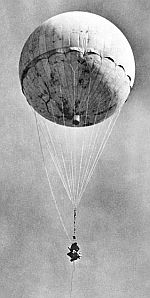
Six killed in Oregon by a Japanese Fu-Go balloon
On this day in 1945, Mrs. Elsie Mitchell and five neighborhood children were killed while attempting to drag a Japanese Fu-Go balloon out the woods in Bly, Oregon becoming the first and only known American civilians to be killed in the continental United States during World War II.
The Fu-Go balloons were launched by Japan across the Pacific riding the Jet Stream since November 1944, in an attempt to create terror by starting massive fires in US west coast's forests. When the balloon offensive ended in April 1945, about 9.300 balloons were launched toward north America of which about 300 were found or observed in the U.S., Canada, and Mexico.
The tight censorship about the balloons impossed by the U.S. government was lifted after the Bly incident to warn the public to stay away form any downed Fu-Go remains they could found. -
May 9 1850

Joseph Louis Gay-Lussac dies
On this day in 1850, died in Paris the French chemist Louis Joseph Gay-Lussac best known for his work on gases. He was born in Saint-Léonard-de-Noblat in 1778.
As a young man, Gay-Lussac had participated in two balloon flights for scientific purposes. In 1804 he ascended in a hydrogen balloon with Jean-Baptiste Biot in order to investigate the Earth's magnetic field at high altitudes and to study the composition of the atmosphere. Also in 1805-06, amid the Napoleonic wars, Gay-Lussac embarked upon a European tour with the Prussian explorer Alexander von Humboldt.
In 1805, by exploding together given volumes of hydrogen and oxygen, he discovered that they combined in ratio 2:1 by volume to form water. By 1808, after researches using other gases, he formulated his famous law of combining volumes - that when gases combine their relative volumes bear a simple numerical relation to each other (e.g., 1:1, 2:1) and to their gaseous product (under constant pressure and temperature).
He also developed techniques of quantitative chemical analysis, confirmed that iodine was an element, discovered cyanogen, improved the process for manufacturing sulphuric acid and prepared potassium and boron. -
May 13 1980
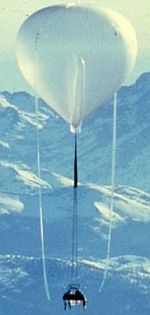
First nonstop transcontinental balloon crossing of North America
On this day in 1980, the Kitty Hawk, a balloon piloted by Maxie Anderson and his son Kris completed the first nonstop transcontinental balloon crossing of North America.
The 11-story-high helium balloon was launched from Fort Baker, an Army base near San Francisco, California and traveled 2,828 miles nonstop in 99 hours and 54 minutes it landed in Grosse Roches, Quebec, near the mouth of the St. Lawrence River.
Originally, the balloon was supposed to land nearly 1,100 miles south of the Quebec meadow in Kitty Hawk, North Carolina. The journey included the forced climb over a thunderstorm in Wyoming, a sprint from South Dakota to Maine and counted in the end with the help of a Canadian military helicopter that was called in to create enough wind for the Kitty Hawk to clear the trees on which the 100-foot long drag ropes got entangled at the landing site.
The feat was covered in detail in the August 1980 edition of the National Geographic magazine. -
May 16 2010
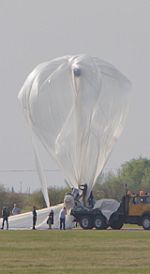
Fourth and last attempt by Michel Fournier of a stratospheric jump
On this day in 2010 French parachutist Michel Fournier attempted for the fourth and last time since 2002 to ascend to the stratosphere in a balloon to perform a high-altitude jump. The project called "Le Gran Saut" (French for the Big Jump) was aimed to beat Joe Kittinger's record set in 1960.
The weather showed very promising so it was decided to start the balloon inflation. However, during the last minutes of the launch countdown, with the balloon fully inflated, Fournier's parachute deployed spontaneously inside the capsule, forcing it to cancel the launch. Running very short of funds to acquire a new balloon, Fournier proposed to reuse the balloon by repacking it and cutting the already inflation portion.
His team refused to back him at that time due to security constraints, and the launch was finally canceled. That would be the last time Fournier will be close to achieving his goal. In further years he struggled to rise funding for a new attempt that would never materialize. -
May 17 2009

First image of the Crab Nebula by a Compton telescope
On this day in 2009, the Nuclear Compton Telescope, an instrumented developed by the University of California, Berkeley performed the first reported detection of an astrophysical source by a compact Compton telescope (CCT), during a 38 hour-long balloon mission over New Mexico. The primary target during the flight was the Crab Nebula.
The result was the first significant detection of a celestial source by a CCT and was an important step in establishing the viability of the CCT design for future space-based wide-survey instruments. -
May 18 2021

Last balloon in flight from Project Loon lands in Australia
On this day in 2021, LN-206 Project Loon's last balloon in flight at the moment, landed at 3:23 utc 70 km SE of Laramba, Australia. The balloon marked the definitive closing of the project and also established the absolute flight record for Loon with 335 days and 23 hours aloft.
During the more than 8 years of the project a total of 2127 flights were performed. The entire fleet acumulated almost two million hours of flight and traveled more than 70 millions of kilometers. Longest flight by distance by a single balloon was 217.260 kilometers. -
May 23 2002
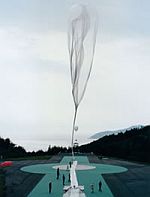
New high altitude record by a Japanese balloon
On this day in 2002, a Japanese balloon launched from the Sanriku Balloon Center by the Institute of Space and Astronautical Science (ISAS) established a new altitude record reaching 53 km.
The balloon nomenclated as BU60-1 was fabricated fron an ultra-thin-film of polyethylene 3.4 micron thick and had a volume of 60000 cubic meters. After launched, the balloon kept ascending slowly at a speed of 265 meters per minute and successfully reached the altitude of 53 km (equivalent to 32.9 miles or 173900 feet) which was 1.2 km higher than the world record altitude of 51.8km, established in 1972 by a balloon launched from Chico, California. The total flight time was 4 hours and 23 minutes.
The success achieved was part of a progressive process that started back in 1997, and included -aside the balloon itself- the development of adhesive agents, manufacturing under strict quality control, the development of air-packed ultra-thin-film balloon launch system, and the envisage of a semi-dynamic balloon launch method. -
May 27 1931
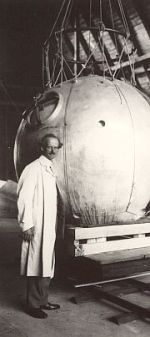
Record flight with the balloon FNRS-1 by Piccard and Kipfer
On this day in 1931, the aeronauts Auguste Piccard and Paul Kipfer took off in the FNRS-1 balloon from Augsburg, Germany. The balloon built by Piccard was named after the Belgian Fonds National de la Recherche Scientifique, which funded it. The mission reached a record altitude of 15,781 m (51,775 ft) establishing a new official record sanctioned by the Fédération Aéronautique Internationale.
During this flight, Piccard was able to gather substantial data on the upper atmosphere, as well as to measure cosmic rays. After completing the observations, the aeronauts tried to descend, but couldn't. While their oxygen tanks emptied, they floated aimlessly over Germany, Austria, and Italy.
Piccard and Kipfer finally landed 17 hours after their first-of-a-kind trip: cool evening air contracted the balloon's gas and brought them down on a glacier near the village of Ober-Gurgl, Austria, with one hour's supply of oxygen to spare. -
May 27 2008
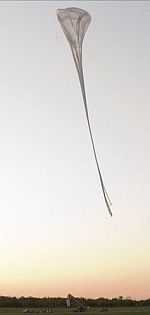
Third attempt by Michel Fournier of a stratospheric jump
On this day in 2008 French parachutist Michel Fournier attempted for the third time since 2002 to ascend to the stratosphere in a balloon to perform a high-altitude jump. The project called "Le Gran Saut" (French for the Big Jump) was aimed to beat Joe Kittinger's record set in 1960.
After a first cancellation the day before due to weather, the pilot was waiting for launch inside the gondola at the airstrip of North Battleford Airport in Canada. However, after releasing the balloon from the launch spool, the gas bag moved to the crane which was holding the capsule but instead pick it up to the sky, it ascended alone without his cargo.
The failure was located in the mechanism that would separate the balloon and the gondola at the end of the flight: an explosive device called "squib" experienced an unexpected firing, setting the balloon free from the capsule. Although Fournier's team was able to recover the balloon after it landed, it was rendered unusable.

